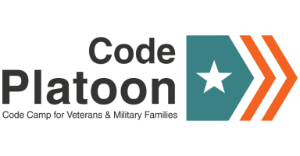Adapting Military Team Building Skills to the Tech World
Imagine a small town. Every day, the townsfolk gather in the same field to let their cows graze. While popular research suggested that the cows would overgraze the pasture, research by (Nobel Prize winner) Elinor Ostrum shows that these communities ably manage their own resources.
People often do their best work in small, communal teams. But as time passes, teams have gotten larger and messier. The tech industry recognizes this, and it is pivoting to Agile teams and a focus on workplace culture. This transition is marked by trust that technology companies place in their employees to manage themselves.
Tech Teams Work Differently than Military Teams
Tech team structures can confuse the outsider. Luckily, Kelly Cronin, a lead ThoughtWorks consultant and Code Platoon Beyond Tech workshop leader, is here to help our students understand how tech teams form and empower them to build better teams.
“Code Platoon students have such a breadth of teamwork experience already,” Kelly said. “That’s why I focus on what their future tech teams look like and the psychology behind them.”
Many of the military teams that Code Platoon students have been part of are what Kelly calls “Command and Control” models. Military teams are traditionally formed around a rigid hierarchy: the top makes the decisions and information flows down from the leaders like a waterfall.
While some tech companies use such rigid models, many workplaces have focused instead on Agile structures. Agile teams are built around motivation, community, and trust instead of structure and control. Agile team members are still given goals and problems to solve, but they are encouraged to develop their solutions and control their projects from end-to-end.
“You will likely end up in a hybrid between silos and Agile teams,” Kelly said. “You will need to push for clarity, define your teams’ roles, and try to be as cross-functional as possible.”
Soft Skills Build Strong Teams
During one workshop, Kelly asked students what qualities they appreciated the most during their military service. Some students defaulted to skill-based qualifications, but many others pointed to soft skills like “listening” or “having each other’s backs.”
The tech workforce also prefers these qualities. According to a 3-year multimillion-dollar Google study, the highest-performing teams were the ones most committed to psychological safety and equal air time, not the ones with the strongest skills.
“The best team members feel safe to ask questions, make mistakes, and be vulnerable with each other,” Kelly explains. “Every team member has the same amount of time to voice their opinion. When team members disagree, they engage in constructive conflicts, and everyone votes together on how to proceed.
“You don’t have to be friends or even like each other very much to make this work. You just have to have established norms, mutual goals, and an understanding that you are there to fail or succeed together.”
Learn More Beyond Tech Transitioning Skills
Kelly’s teamwork workshop is just one of eight topics covered in Code Platoon’s Beyond Tech curriculum. Beyond Tech teaches our Veteran, active duty Servicemember, and military spouse students the norms and conventions of the civilian technology workforce. Other interpersonal Beyond Tech topics include overcoming imposter syndrome, diversity and inclusion, and interview prep. Learn more about our Beyond Tech curriculum.
Kayla Elkin is the Marketing Content Specialist at Code Platoon. In this role, she utilizes her marketing, writing, and editing skills developed by previous positions in higher education and educational technology. Kayla has degrees in English and Sociology from Clemson University and completed the Study in India Program (SIP) at the University of Hyderabad. She lives with her partner in northern Chicago.
Subscribe To Our Newsletter
Join our mailing list to receive the latest news and updates from our team.
Thank you for subscribing to our email list!

